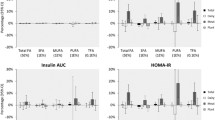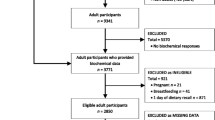Abstract
Aim of the study
To analyse the association of trans fatty acid (TFA) consumption with the risk of type 2 diabetes and lifestyle in a South European population.
Methods
Data were obtained from two population-based cross-sectional surveys conducted in Gerona (Spain) in 2000 and 2005. The present analysis included 7,774 free-living Spanish men and women aged 35–74 years. Diet was assessed by a validated food frequency questionnaire. Fasting blood sugar was measured and history of diabetes recorded.
Results
trans Fatty acid intake was relatively low in our study population (1.5 g d−1 for women and 1.8 g d−1 for men). Multiple logistic regression analysis revealed a null association between TFA intake and risk of type 2 diabetes in men and women. Total energy intake, alcohol consumption and the prevalence of smoking increased across quartiles of TFA intake. An inverse association was found between TFA intake and the consumption of vegetables, fruit, fish, legumes, white bread and olive oil in both genders (p < 0.001) after adjusting for energy intake. In contrast, intakes of meat, sausages and pastry products increased across quartiles of TFA intake in both genders (p < 0.001).
Conclusions
trans Fatty acid intake was not associated with a higher risk of type 2 diabetes. Higher TFA intake was associated with less healthy lifestyle and dietary habits in both sexes.

Similar content being viewed by others
References
Odegaard AO, Pereira MA (2006) trans Fatty acids, insulin resistance, and type 2 diabetes. Nutr Rev 64:364–372
Wild S, Roglic G, Green A, Sicree R, King H (2004) Global prevalence of diabetes: estimates for the year 2000 and projections for 2030. Diabetes Care 27:1047–1053
Engelgau MM, Geiss LS, Saaddine JB et al (2004) The evolving diabetes burden in the United States. Ann Intern Med 140:945–950
Steyn NP, Mann J, Bennett PH, Temple N, Zimmert P, Tuomilehto J, Lindström J, Louheranta A (2004) Diet, nutrition and the prevention of type 2 diabetes. Public Health Nutr 7:147–165
Riserus U (2006) trans Fatty acids and insulin resistance. Atheroscler Suppl 7:37–39
Riserus U, Willet WC, Hu FB (2009) Dietary fats and prevention of type 2 diabetes. Prog Lipid Res 48:44–51
Ascherio A, Katan MB, Zock PL, Stampfer MJ, Willett WC (1999) trans Fatty acids and coronary heart disease. N Engl J Med 340:1994–1998
Willett WC, Stampfer MJ, Manson JE, Colditz GA, Speizer FE, Rosner BA, Sampson LA, Hennekens CH (1993) Intake of trans fatty acids and risk of coronary heart disease among women. Lancet 341:581–585
Ascherio A, Rimm EB, Giovannucci EL, Spiegelman D, Stampfer M, Willet WC (1996) Dietary fat risk of coronary heart disease in men: cohort follow up study in the United States. BMJ 313:84–90
van de Vijver LPL, Kardinaal AFM, Couet C, Aro A, Kafatos A, Steingrimsdottir G et al (2000) Association between trans fatty acid intake and cardiovascular risk factors in Europe: the TRANSFAIR study. Eur J Clin Nutr 54:126–135
Craig-Schmidt MC (2006) World-wide consumption of trans fatty acids. Atheroscler Suppl 7:1–4
Schröder H, Covas MI, Marrugat J, Vila J, Pena A, Alcántara M, Masiá R (2001) Use of three-day estimated food record, a 72-hour recall and a food-frequency questionnaire for dietary assessment in a Mediterranean Spanish population. Clin Nutr 20:429–437
Cuadrado C, Carbajal A, Nuñez C, Ruiz-Roso B, Moreiras O (1998) Spanish contribution to the creation of a European analytical database of trans-fatty acids. Nutr Hosp 13:21–27
Expert Committee on the Diagnosis, Classification of Diabetes Mellitus (2003) Report of the expert committee on the diagnosis and classification of diabetes mellitus. Diabetes Care 26(Suppl 1):S5–S20
Elosua R, Garcia M, Aguilar A, Molina L, Covas MI, Marrugat J (2000) Validation of the Minnesota leisure time physical activity questionnaire in Spanish women. Investigators of the MARATDON Group. Med Sci Sports Exerc 32:1431–1437
Elosua R, Marrugat J, Molina L, Pons S, Pujol E (1994) Validation of the Minnesota leisure time physical activity questionnaire in Spanish men. Investigators of the MARATDON Group. Am J Epidemiol 139:1197–1209
Passa P (2002) Diabetes trends in Europe. Diabetes Metab Res Rev 18(Suppl 3):S3–S8
Valdes S, Rojo-Martinez G, Soriguer F (2007) Evolution of prevalence of type 2 diabetes in adult Spanish population. Med Clin (Barc) 129:352–355
Alsrup KK, Gregersen S, Jensen HM, Thomsen JL, Hermansen K (1999) Differential effects of cis and trans fatty acids on insulin release from isolated mouse islets. Metabolism 48:22–29
Ibrahim A, Natarajan S, Ghafoorunissa R (2005) Dietary trans fatty acids alter adipocyte plasma membrane fatty acid composition and insulin sensitivity in rats. Metabolism 54:240–246
Natarajan S, Ibrahim A (2005) Dietary trans fatty acids alter diaphragm phospholipid fatty acid composition, triacylglycerol content and glucose transport in rats. Br J Nutr 93:829–833
Lefevre M, Lovejoy JC, Smith SR, Delany JP, Champagne C, Most MM, Denkins Y, de Jonge L, Rood J, Bray GA (2005) Comparison of the acute response to meals enriched with cis- or trans-fatty acids on glucose and lipids in overweight individuals with differing FABP2 genotypes. Metabolism 54:1652–1658
Louheranta AM, Turpeinen AK, Vidgren HM, Schwab US, Uusitupa MI (1999) A high-trans fatty acid diet and insulin sensitivity in young healthy women. Metabolism 48:870–875
Salmeron J, Hu FB, Manson JE, Stampfer MJ, Colditz GA, Rimm EB, Willet WC (2001) Dietary fat intake and risk of type 2 diabetes in women. Am J Clin Nutr 73:1019–1026
Meyer KA, Jacobs DR, Kushi LH, Folsom AR (2001) Dietary fat and incidence of type 2 diabetes in older Iowa women. Diabetes Care 24:1528–1535
Van Dam RM, Stampfer MJ, Willet WC, Rimm EB, Hu FB, Rimm EB (2002) Dietary fat and meat intake in relation to risk of type 2 diabetes in men. Diabetes Care 25:3
Lopez-Garcia E, Schulze MB, Meigs JB, Manson JE, Rifai N, Stampfer MJ, Willett WC, Hu FB (2005) Consumption of trans fatty acids is related to plasma biomarkers of inflammation and endothelial dysfunction. J Nutr 135:562–566
Mozzafarian D, Pischon T, Hankinson RifaiN, Joshipura K, Willet WC, Rimm EB (2004) Dietary intake of trans fatty acids and systematic inflammation in women. Am J Clin Nutr 79:606–612
Harnack L, Lee S, Schakel SF, Duval S, Luepker RV, Arnett DK (2003) Trends in the trans-fatty acid composition of the diet in a metropolitan area: the Minnesota Heart Survey. J Am Diet Assoc 103:1166
Hulshof KF, van Erp-Baart MA, Anttolainen M, Becker W, Church M, Couet C et al (1999) Intake of fatty acids in Western Europe with emphasis on trans fatty acids: the TRANSFAIR Study. Eur J Clin Nutr 53:143–157
Cantwell MM, Flynn MA, Cronin D, O’Neil JP, Gibney MJ (2005) Contribution of foods to trans unsaturated fatty acid intake in a group of Irish adults. J Hum Nutr Diet 18:377–385
Skeaff CM, Gowans S (2006) Home use of margarine is an important determinant of plasma trans fatty acid status: a biomarker study. Br J Nutr 96:377–383
Mozaffarian D, Aro A, Willett WC (2009) Health effects of trans-fatty acids: experimental and observational evidence. Eur J Clin Nutr 63:S5–S21
Acknowledgments
We appreciate the English revision by Elaine M. Lilly PhD (Writer’s First Aid). This research was supported by grant 2FD097-0297-CO2-01 from Fondo Europeo de Desarrollo Regional (FEDER) and in part by the Ministerio de Sanidad y Consumo, Miguel Servet Instituto de Salud Carlos III, CIBER: Fisiopatología de la obesidad y nutrición CB06/03/0028, Fondo de Invesigación Sanitaria ISCIII CP 03/00115.
Author information
Authors and Affiliations
Corresponding author
Additional information
For the REGICOR Investigators. A full roster of REGICOR investigators and collaborators can be found at http://www.REGICOR.org/regicor_inv.
Rights and permissions
About this article
Cite this article
Papantoniou, K., Fíto, M., Covas, MI. et al. trans Fatty acid consumption, lifestyle and type 2 diabetes prevalence in a Spanish population. Eur J Nutr 49, 357–364 (2010). https://doi.org/10.1007/s00394-010-0093-z
Received:
Accepted:
Published:
Issue Date:
DOI: https://doi.org/10.1007/s00394-010-0093-z




